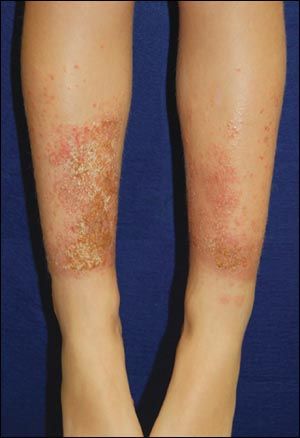Shin Guard Dermatitis
A 10-year-old boy had increasing irritation and itching of the lower legs for the past 5 weeks. The boy was an avid soccer player. Examination revealed an acutely inflamed, exudative dermatitis on the anterior aspect of both legs.
A 10-year-old boy had increasing irritation and itching of the lower legs for the past 5 weeks. The boy was an avid soccer player.
Examination revealed an acutely inflamed, exudative dermatitis on the anterior aspect of both legs. The location of the rash corresponded with the area of skin in contact with the child’s soccer shin guards. He had had no contact with other foreign objects or substances.

Relatively little is written in the literature about shin guard dermatitis. It remains controversial whether the dermatitis is a form of allergic contact dermatitis or a reaction to local irritants, such as heat, sweat, and friction.1 The allergen para-tertiary- butylphenol-formaldehyde resin has been implicated in some cases.2 In a study of patients with persistent or recurrent shin guard dermatitis, results of epicutaneous tests and patches of material taken from shin guards were negative for an allergen; the authors concluded that the patients had irritant contact dermatitis caused by sweating and friction.1
Treatment of this dermatitis consists of temporary discontinuation of the shin guards. The use of topical corticosteroids and emollients is routinely effective in the acute inflammatory phase. With return of the shin guards, use of a barrier, such as a clean cotton cloth or other absorbent material, is recommended. Duct tape placed on the inside of the shin guards has also been effective.3
This patient went without shin guards for 2 weeks and applied a moderate-potency corticosteroid ointment twice daily and an emollient 3 times daily. He also obtained athletic cotton sleeves to wear under the shin guards, which he lined with the same cotton material. He was instructed to continue the use of emollients and to apply the corticosteroid ointment at the first sign of recurrence. In addition, he was advised to wash his legs and his shin guards after each use.
References:
REFERENCES:
1. Weston WL, Morelli JG. Dermatitis under soccer shin guards: allergy or contactirritant reaction?
Pediatr Dermatol
. 2006;23:19-20.
2. Hsu J, Jacob SF. The other side of athletic safety gear in adolescents: the roleof p-tert-butylphenol-formaldehyde-resin in allergic contact dermatitis.
J DermatolNurses Assoc.
2009;1:198-200.
3. Ghali FE, Agim N. Emerging patterns of contact dermatitis.
Skin & Aging
.2008;16.
http://www.skinandaging.com/article/9041
. Accessed September 21,2010.
Recognize & Refer: Hemangiomas in pediatrics
July 17th 2019Contemporary Pediatrics sits down exclusively with Sheila Fallon Friedlander, MD, a professor dermatology and pediatrics, to discuss the one key condition for which she believes community pediatricians should be especially aware-hemangiomas.
Itchy skin associated with sleep problems in infants
September 27th 2024A recent study presented at the American Academy of Pediatrics 2024 National Conference & Exhibition, sheds light on the connection between skin conditions and sleep disturbances in infants and toddlers, highlighting itchy skin as a significant factor, even in the absence of atopic